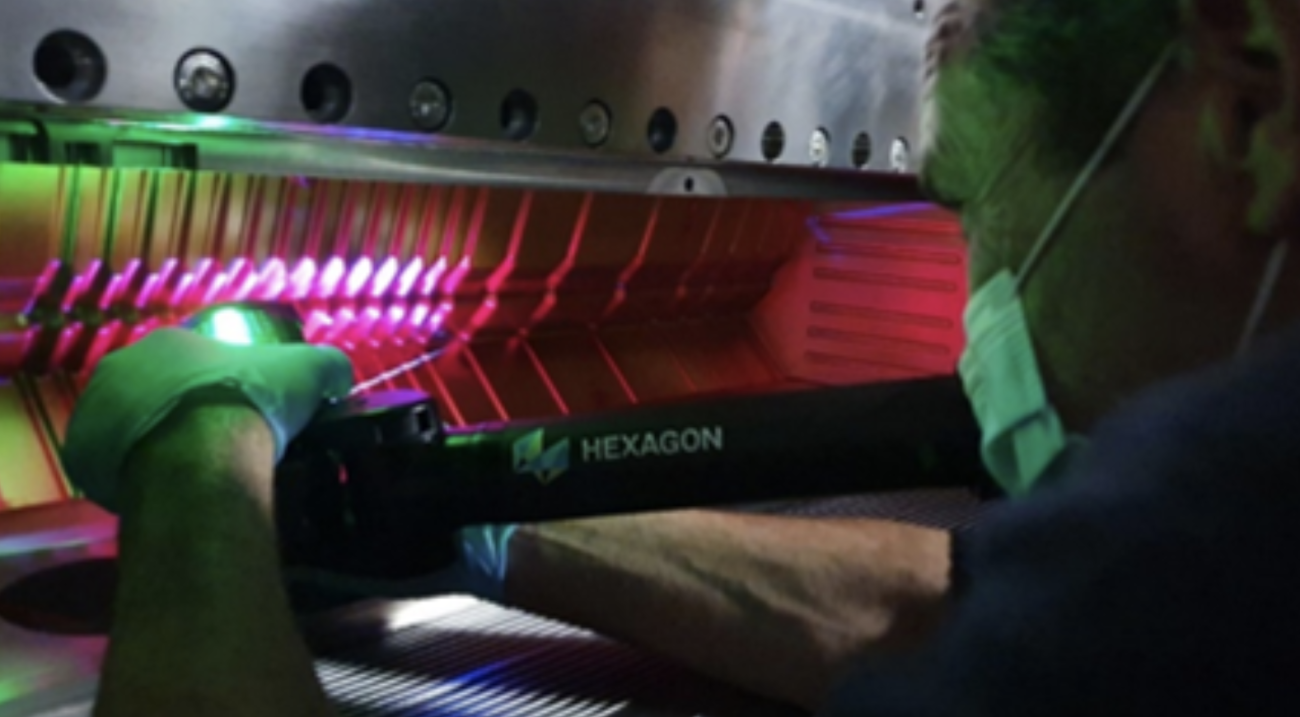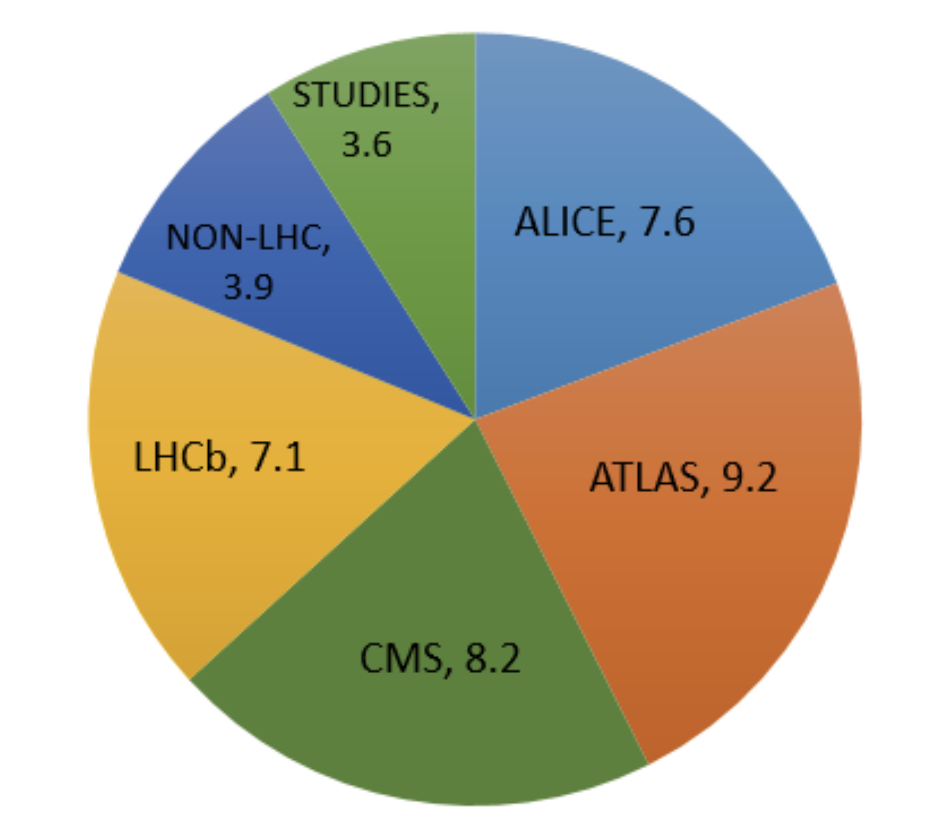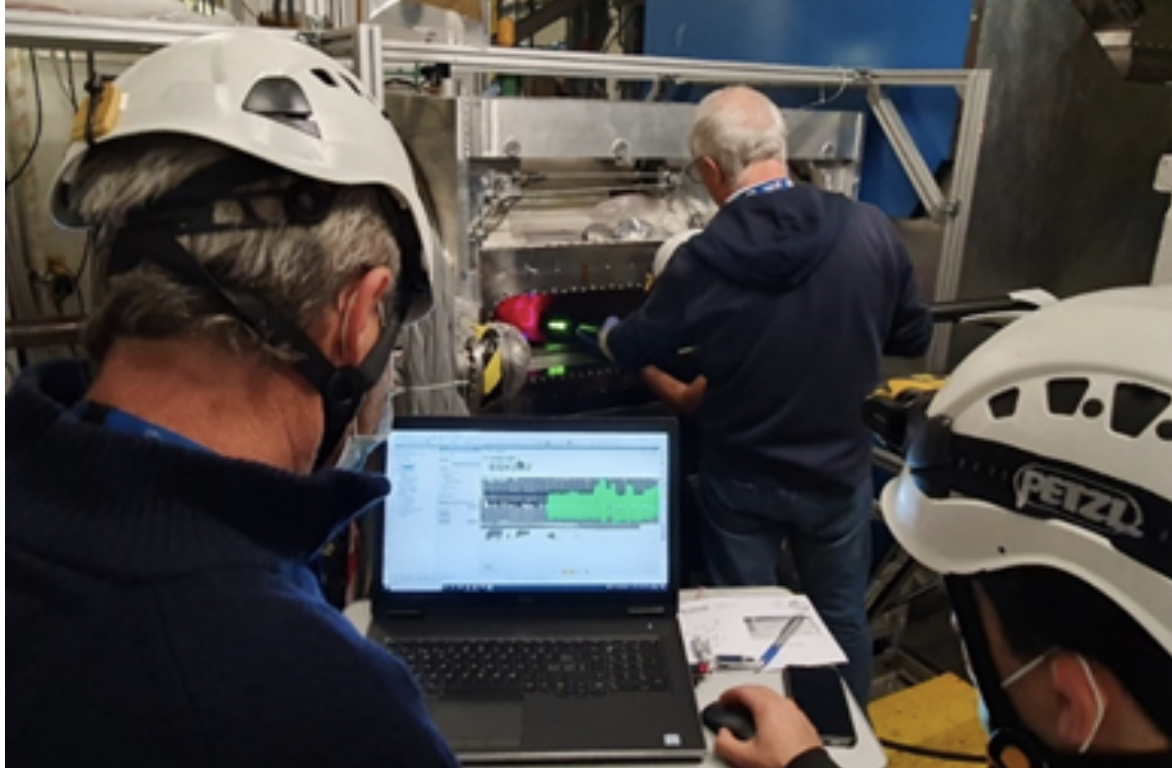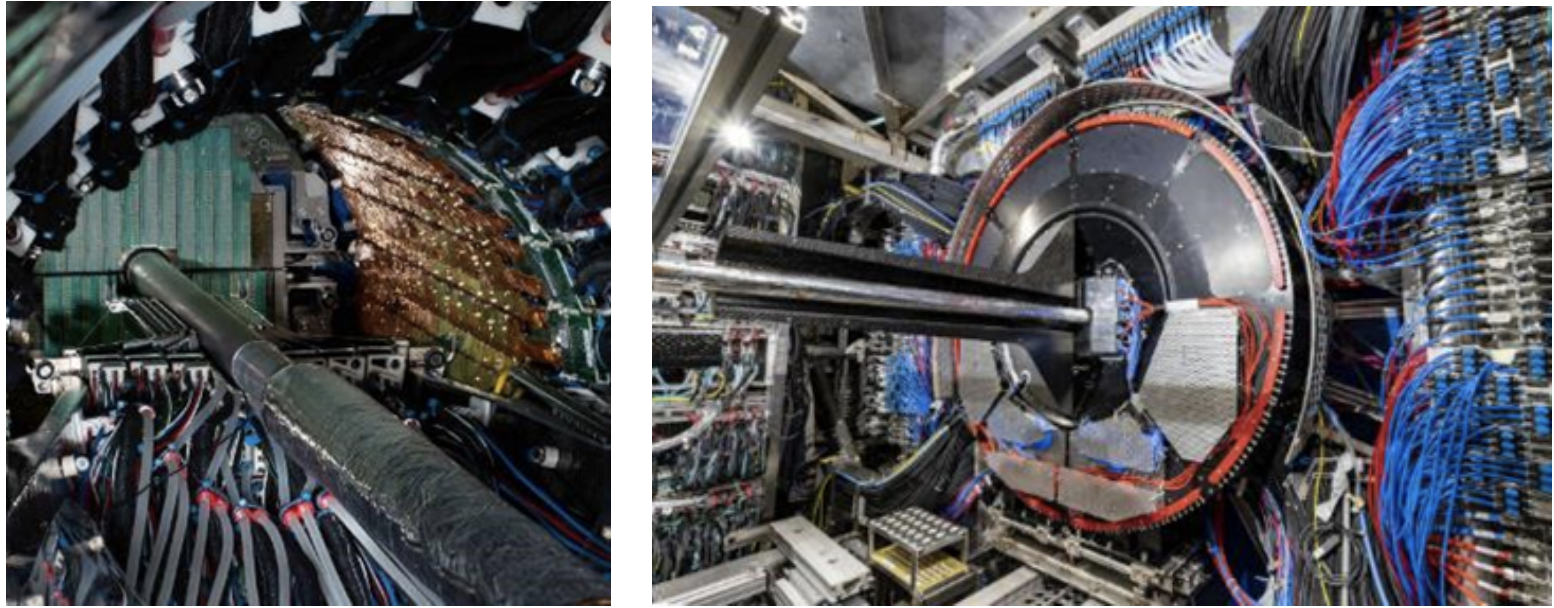DT group publishes 2021 annual report

The mandate of the Detector Technologies (DT) group in the Experimental Physics department covers development, construction, operation and maintenance of particle detectors for CERN experiments. Last year showed great progress on several projects both for the LHC and non-LHC experiments, as detailed in the recent annual report. Moreover, DT teams are strongly involved in the new strategic R&D programme on experimental technologies launched by CERN’s EP department contributing in R&D advancements.
According to the report, the group structure is set to optimize the support to the experiments taking into account their needs and plans for LHC Phase I and Phase II. One of the challenges in organizing the human resources within DT is the fact that contributions to projects such as the LHC detector upgrades have to be balanced with the significant responsibilities of the group to the services, such as the Gas- and CO2-Cooling- systems of the CERN experiments. This calls for a flexible organization that will provide centralized expertise to exploit specialist experience at its maximum potential. The following diagram shows the distribution of DT personnel across different activities.

The above charts provide details for the contributions of the DT Staff members to various projects and services.
Over the past year, the DT group played a key role in the final testing of the upgrades for the LHCb and ALICE detectors. For the LHCb experiment upgrade, the new scintillating fibre tracking detector (SciFi) was completely assembled and installed in the cavern as reported in EP newsletter (here & here). The assembly of the detector was partially lead by a DT member and several additional contributions were made to ensure the schedule The services of SciFi have been finalized and commissioned throughout the year, including a cooling plant based on NOVEC/C6F14 which has been installed under DT supervision with the plant being built by EN-CV. The cooling lines are vacuum isolated and DT-DI has designed and built the controls for the vacuum system. The system has been brought into operation in 2021 and has performed without any problems. Furthermore, the new LHC RICH photodetectors were fully characterized and commissioned. Full support was provided for the installation of the new RICH1 gas enclosure and all related services and for the coating of the RICH1 mirrors and quartz plates. Magnetic field measurements inside the RICH1 iron shield were made possible with the help and support of the DT dedicated service. The lab commissioning of 22 columns of multi-anode photomultipliers (MaPMTs) for the RICH1 detector has been successfully achieved, in line with the very tight planning imposed by the overall LHCb installation schedule. In addition, the DT group was here actively involved in the mechanical mounting, optical and electrical cabling, and testing operations. The pit installation and commissioning of MaPMT columns, and all related service infrastructure for RICH 2 was completed much in advance of the LHC beam tests of October 2021. This activity culminated with the successful detection of Cherenkov rings. Owing to the pandemic, the group has also been taking over many activities related to the RICH1 detector and initially assigned to external institutes. These activities included full support for the gas vessel, cooling and gas systems, service infrastructures, cabling, etc. All MaPMT columns are now installed in RICH1 and are currently being commissioned using the LHCb online and control systems. Furthermore, members of DT actively contributed to the construction and installation of the new VELO detector, and took care of the implementation of the VELO safety and motion control systems. EP-DT has been central to the VELO assembly providing guidance but also acting as the major point of reference for all VELO mechanics in the project. A metrology measurement with the recently acquired laser Romer arm (portable CMM) has been provided in autumn 2021.

Absolute measurement of the VELO RF foil with the Romer arm.
For ALICE, one of the milestones was the installation and commissioning of the safety system for the ALICE ITS2 inner tracker, a crucial step before the full commissioning of the detector. In May 2022, after the installation of the Muon Forward Tracker (December 2021) and of the ITS Outer Tracker system (March 2022) it was the turn of the ITS Vertex Detector. The ITS installation requested an unparalleled preparation effort from the engineering teams of DT and AIO. Before installation a detailed insertion procedure was developed using a full 3D of the Detectors halves, their matching simulation through CAD models, the construction of a remote-control system and of a monitoring cameras-network to control the movements. Moreover, a full mockup of the cavern environment was used to exercise the installation procedure, first through dummy barrels, and after with the real detector barrels prior to moving them in the cavern. Last May, the installation phases of the ITS Vertex Detector were successfully completed. The installation of the ALICE new central detectors installation was completed with the lowering in the cavern of the Fast Interaction Trigger (FIT), a 300-kg disk that will serve as an interaction trigger, as an initial indicator of the vertex position and as a forward multiplicity counter. The FIT was secured next to the central tracking detectors through a dedicated rails system that allows its opening to provide access to the ITS for maintenance. DT group also contributes in the plans for the next ITS upgrade, ITS3, that has already passed a number of critical milestones as recently reported HERE.

The Bottom half of the ITS Inner Barrel installed around the beampipe (left) and the installaiton of the Fast Interaction Trigger (FIT) (right).
Further to these LS2-related activities, various other tasks were accomplished by the DT group, such as thermomechanical tests for the future ATLAS Inner Tracker (ITk) and the corresponding radiation qualifications. ITk is an all-silicon tracker capable of coping with the HL-LHC demands that will replace the current Inner Detector during the Long Shutdown 3. It comprises a Strip Tracker and a five-layer Pixel detector. DT group plays a crucial role in the development of the latter, working closely with EP-ADE on the design, prototyping and coordination aspects pertaining to the Pixel Outer Barrel (OB). In 2021 the DT group continued leading the mechanical design for the Outer Barrel, focusing on the local supports, the global structures, the cooling manifolds and the overall detector integration. As in previous years, these activities were carried out in close collaboration with the Université de Genève. An important part of the DT resources was devoted to finalising the design qualification of the bare local supports. A series of partial and full-size prototypes of the longerons and inclined half rings for layer 3 were built and tested to evaluate their thermal, mechanical and electrical performance. The design of the OB global structures also progressed significantly in 2021.
DT also contributes in the CMS Tracker upgrade with the design and construction of the “Tilted TBPS” sub-detector that will contain Pixel-Strip (PS) modules tilted towards the beam interaction point. In 2021 the focus was in final detail design of the detector and launching manufacture and procurement of sub-components and tooling in view of pre-production launch in 2022. An essential part of this effort was setting up of the Tilted TBPS production facility in CERN building 187. The building was transformed from its previous use (scintillator production and mock-up work) to an appropriately clean and temperature/humidity-controlled space for high-precision assembly work. Significant progress was made with sensor characterisation and ensuing design optimisation for the silicon sensors of the future CMS high-granularity endcap calorimeters (HGCAL). The CERN team represents a crucial input for defining the sensor production parameters for the large HGCal silicon order, for the annealing scenario to be used in the final detector, and for the sensor testing infrastructure to be used in the coming production phases of the HGCal. Advances were made in monolithic pixel detector technology in close collaboration with the EP-ESE-ME section.
Beyond the LHC experiments, DT continued through 2021 to provide technical support to CERN’s Small and Medium Experiments, such as NA62 (an article detailing the transformation of NA62 was recently published in EP newsletter), CLOUD (EP news - CLOUD experiment makes its own clouds to Study) and AEgIS, for which they worked on the design and construction of a new central target system. DT contributed as well ot he reconstruction of the CLOUD Facility as part of the PS East Hall renovation project. Several options for the muon shield of a future Beam Dump Facility (BDF) were assessed with the aim of reaching very low background fluxes.
The contributions to the DAQ and DCS for the CERN Neutrino Platform activities continues, as well as developments for the DUNE experiment that will be hosted by Fermilab and the proposal for a new Search for Hidden Particles (SHiP) experiment. Finally, DT continues contributing to detector studies for possible future colliders.
These achievements were only made possible thanks to the work and support of the different DT sections. Combining detector development services with high-level expertise in silicon and gaseous detectors, the Detector Development section has an indispensable role; the section continues working on the ATLAS and CMS upgrades while also involved in R&D programmes through the RD50 and RD51 collaborations. Furthermore, several members are activity coordinators in international R&D initiatives, such as the H2020 AIDAinnova, RADNEXT and EUROLABS. Research on detector technologies also requires state-of-the-art facilities like those offered by DT, including the departmental Silicon Facility with the wire bonding and interconnect facility, the quality and reliability assurance lab and the EP irradiation facilities frequently covered in our newsletter. In 2021 the PS area has undergone major upgrades including the IRRAD facility managed by a team in EP-DT-DD. The GIF++ facility has provided key support for the LS2 detector upgrades (e.g. ATLAS NSW, ALICE TPC) as well as for the phase II upgrade studies. The Bondlab continued to provide a unique wire bonding service to all experiments and a large number of projects. Finally, the QARTlab and DSF cleanroom saw a continuous increase of activities, many now focussing on the tracker phase II upgrades of ATLAS and CMS.
Crucial is also the role of the FS team working on developing new gas and cooling systems to meet the detector specific requirements. Further to the design phase, the section has direct access to a specialized mechanical and electrical workshop, which produced most of the systems currently in use for the CERN experiments. The team also designs and develops related software for the controls system following the latest CERN standards in connection with the BE-ICS section. Today, the FC section is responsible for the operation and maintenance of more than 40 gas systems and 8 CO2 cooling plants for the CERN LHC and non-LHC experiments. Completion of maintenance and upgrades for the 30 gas systems and 4 cooling plants for the LHC experiments. It successfully worked on the restart of all gas systems and cooling plants for LHC Run 3 while work is ongoing for the construction of four new gas systems (CLOUD, NA61-TOF, ND280-TPC, NA64) and 2 cooling plants (LHCb Velo and UT) for LHC and non-LHC experiments.
Vital for DT activities is also to the work of the Detector Interface (DI) section that supports experiments and facilities by designing, constructing, and operating safety, control, trigger and data acquisition systems. The team offers services across a wide range, including the LHC experimental magnets safety, control, and diagnostics, and the DUNE trigger and data acquisition. The collaboration with the BE department for industrial control hardware and software, and the fruitful partnership with the IT department offered fruitful results allowing them to stand up for their mission. In parallel to work on development, commissioning and operation of trigger and data acquisition systems (DUNE, FASER, NA61, NA62), the team is investing in R&D for data acquisition systems for ATLAS Phase II, NA62 and DUNE while also making the setups for the control and safety systems for LHC experiments in light of LS3.
Prototyping, building, installing and commissioning all these detectors and service systems is also required.. The Engineering Office and the Construction & Operations sections continue providing facilities and test benches for the core technologies of particle detectors at CERN as well as the needed tools. Teams are working with detector experts and facility experts to understand needs and develop suitable solutions. The development, production and commissioning is often done jointly with project members and external users, thus offering an opportunity for evolving know-how and enlarging the set of common solutions that can be disseminated to other experiments. The expertise serves all LHC experiments and several other CERN experiments, with tasks ranging from early R&D phase to construction and maintenance of detectors and their subsystems.
Successfully performing these activities requires a safe work space and safety is one of the key priorities for the DT group as demonstrated in the report. Following the relaxation of some of the constraining measures to fight the COVID19 pandemic, teams started progressively using the different workshops and laboratories. Personal protective equipment such as masks and distancing when possible still apply to avoid a steep rise of cases. Several risk analyses have been carried out in collaboration with the Safety Office of EP and the CERN HSE unit, leading to the installation of HEPA filtration units in several places. In parallel, DT group continues inspecting the status of the equipment. An analysis of the conformity of EP machines in the workshops and laboratories under the responsibility of EP-DT were completed and verified that the INFOR database for the 365 machines under the responsibility of EP-DT remains up to date and in line with the general CERN safety rules.
